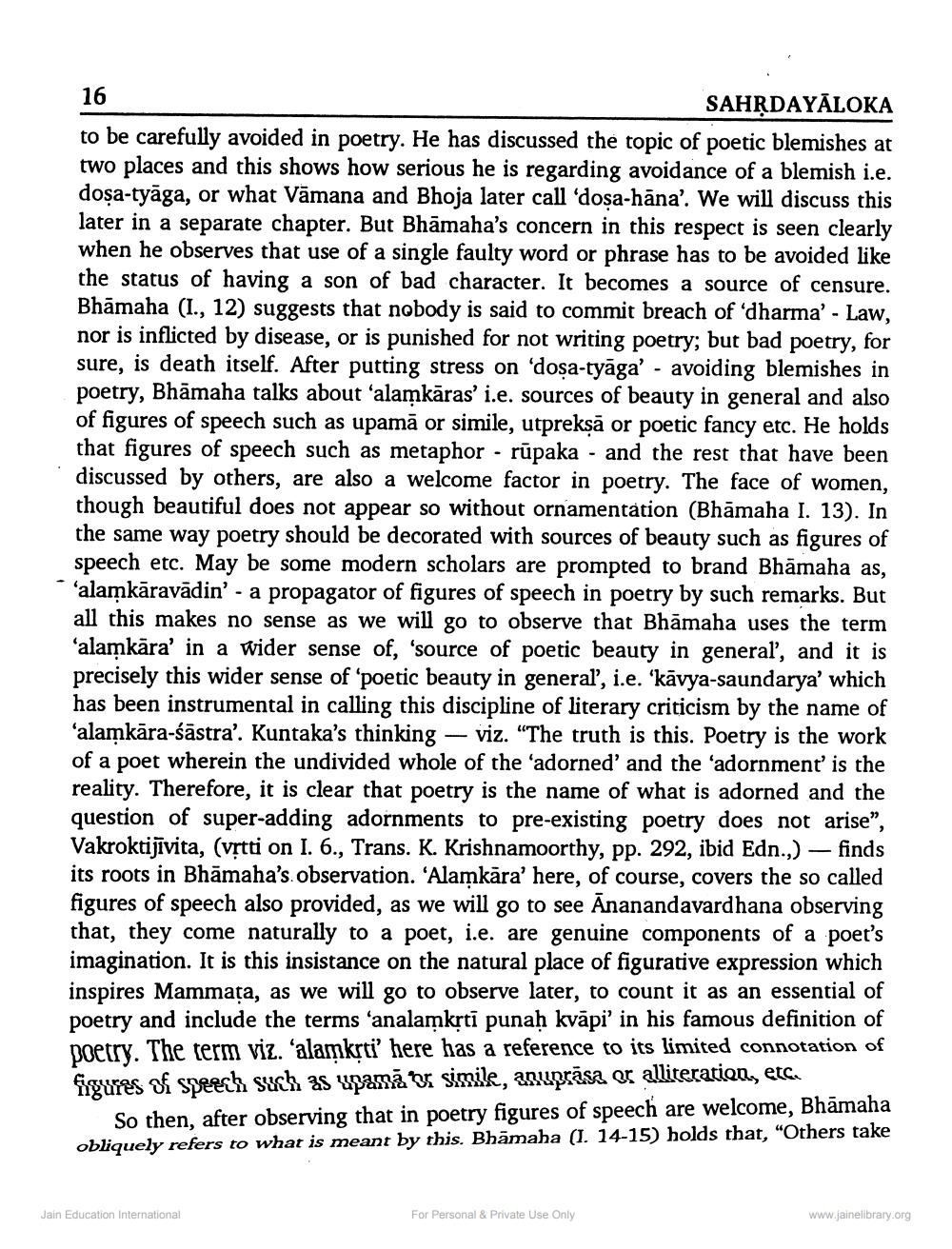________________
16
SAHRDAYĀLOKA to be carefully avoided in poetry. He has discussed the topic of poetic blemishes at two places and this shows how serious he is regarding avoidance of a blemish i.e. doșa-tyāga, or what Vāmana and Bhoja later call 'dosa-hāna'. We will discuss this later in a separate chapter. But Bhāmaha's concern in this respect is seen clearly when he observes that use of a single faulty word or phrase has to be avoided like the status of having a son of bad character. It becomes a source of censure Bhāmaha (I., 12) suggests that nobody is said to commit breach of dharma' - Law, nor is inflicted by disease, or is punished for not writing poetry; but bad poetry, for sure, is death itself. After putting stress on dosa-tyāga' - avoiding blemishes in poetry, Bhāmaha talks about ‘alamkāras' i.e. sources of beauty in general and also of figures of speech such as upamā or simile, utpreksā or poetic fancy etc. He holds that figures of speech such as metaphor - rūpaka - and the rest that have been discussed by others, are also a welcome factor in poetry. The face of women, though beautiful does not appear so without ornamentation (Bhāmaha I. 13). the same way poetry should be decorated with sources of beauty such as figures of speech etc. May be some modern scholars are prompted to brand Bhāmaha as, 'alamkāravadin' - a propagator of figures of speech in poetry by such remarks. But all this makes no sense as we will go to observe that Bhāmaha uses the term ‘alamkāra' in a wider sense of, 'source of poetic beauty in general, and it is precisely this wider sense of 'poetic beauty in general, i.e. 'kāvya-saundarya' which has been instrumental in calling this discipline of literary criticism by the name of 'alamkāra-śāstra'. Kuntaka's thinking - viz. "The truth is this. Poetry is the work of a poet wherein the undivided whole of the ‘adorned' and the ‘adornment is the reality. Therefore, it is clear that poetry is the name of what is adorned and the question of super-adding adornments to pre-existing poetry does not arise”, Vakroktijīvita, (vrtti on I. 6., Trans. K. Krishnamoorthy, pp. 292, ibid Edn.,) – finds its roots in Bhāmaha's observation. 'Alamkāra' here, of course, covers the so called figures of speech also provided, as we will go to see Ānanandavardhana observing that, they come naturally to a poet, i.e. are genuine components of a poet's imagination. It is this insistance on the natural place of figurative expression which inspires Mammata, as we will go to observe later, to count it as an essential of poetry and include the terms 'analamkrti punah kvāpi' in his famous definition of poetry. The term viz. 'alamkrti' here has a reference to its limited connotation of figures of speech such as pamah simile, anuprāsa er alliteration, etc.
So then, after observing that in poetry figures of speech are welcome, Bhāmaha obliquely refers to what is meant by this. Bhamaha (I. 14-15) holds that, "Others take
Jain Education International
For Personal & Private Use Only
www.jainelibrary.org




